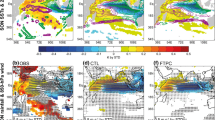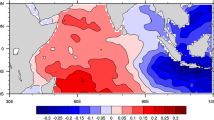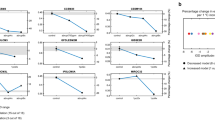Abstract
The Indian Ocean Dipole (IOD) is one of the major climate modes in the tropical Indian Ocean (TIO), influencing the surrounding climate and society. Under anthropogenic warming, the IOD is modulated by the changes in the ocean–atmosphere coupling in the TIO. This study focuses on the IOD seasonal phase locking, which means that the IOD usually peaks in boreal autumn. Based on high-emission scenario future projections, we found that the IOD phase locking changes substantially under anthropogenic warming. The early onset positive IOD that peaks in boreal summer occurs more frequently in the future climate. Our further investigation reveals that this robust change in IOD phase locking is related to the mean state responses to global warming. The shallower thermocline in the eastern equatorial IO is more suitable for IOD developing, helping IOD strengthen in boreal summer. When the basin-wide IOD pattern has fully developed, by contrast, the weakened atmospheric feedback is not conducive to maintaining zonal sea surface temperature gradient, leading to IOD weakened in boreal autumn. Therefore, the IOD peaks earlier under global warming. The change in IOD phase locking shows a potential impact on the surrounding climate, such as Indian summer monsoon variability.













Similar content being viewed by others
References
Annamalai H, Xie S-P, McCreary JP, Murtugudde R (2005) Impact of Indian Ocean sea surface temperature on developing El Niño. J Clim 18:302–319
Ashok K, Saji NH (2007) On impacts of ENSO and Indian Ocean Dipole events on the sub-regional Indian summer monsoon rainfall. Nat Hazards 42(2):273–285
Ashok K, Guan Z, Yamagata T (2001) Impact of the Indian Ocean Dipole on the relationship between the Indian monsoon rainfall and ENSO. Geophys Res Lett 28:4499–4502
Ashok K, Guan Z, Yamagata T (2003) Influence of the Indian Ocean dipole on the Australian winter rainfall. Geophys Res Lett 30:1821. https://doi.org/10.1029/GL2003017926
Ashok K, Guan Z, Saji NH, Yamagata T (2004a) Individual and combined influences of ENSO and the Indian Ocean Dipole on the Indian summer monsoon. J Clim 17:3141–3155
Ashok K, Chan W-L, Motoi T, Yamagata T (2004b) Decadal variability of the Indian Ocean dipole. Geophys Res Lett 31:L24207. https://doi.org/10.1029/2004GL021345
Behera SK, Yamagata T (2003) Influence of the Indian Ocean Dipole on the Southern Oscillation. J Meteorol Soc Jpn 81:169–177
Behera SK, Luo J-J, Masson S, Delecluse P, Gualdi S, Navarra A (2005) Paramount impact of the Indian Ocean dipole on the east African short rains: a CGCM study. J Clim 18:4514–4530
Behera SK, Luo J-J, Masson S, Rao SA, Sakuma H, Yamagata T (2006) A CGCM study on the interaction between IOD and ENSO. J Clim 19:1688–1705
Bjerknes J (1969) Atmospheric teleconnections from the equatorial Pacific. Mon Weather Rev 97:163–172
Black E, Slingo J, Sperber KR (2003) An observational study of the relationship between excessively strong short-rains in coastal East Africa and Indian Ocean SST. Mon Weather Rev 131:74–94
Cai W, Cowan T (2013) Why is the amplitude of the Indian Ocean Dipole overly large in CMIP3 and CMIP5 climate models? Geophys Res Lett 40:1200–1205
Cai W, van Rensch P, Cowan T, Hendon HH (2011) Teleconnection pathways of ENSO and the IOD and the mechanisms for impacts on Australian rainfall. J Clim 24:3910–3923
Cai W, Zheng X-T, Weller E, Collins M, Cowan T, Lengaigne W, Yu W-D, Yamagata T (2013) Projected response of the Indian Ocean Dipole to greenhouse warming. Nat Geosci 6:999–1007
Cai W, Santoso A, Wang G, Weller E, Wu L, Ashok K et al (2014) Increased frequency of extreme Indian Ocean Dipole events due to greenhouse warming. Nature 510:254–258
Du Y, Cai W, Wu Y (2013) A new type of the Indian Ocean dipole since the mid-1970s. J Clim 26:959–972
Fischer A, Terray P, Guilyardi E, Gualdi S, Delecluse P (2005) Two independent triggers for the Indian Ocean Dipole/zonal mode in a coupled GCM. J Clim 18:3428–3449
Guan Z, Yamagata T (2003) The unusual summer of 1994 in East Asia: IOD teleconnections. Geophy Res Lett 30:1544
Huang P, Zheng X-T, Ying J (2019) Disentangling the changes in the Indian Ocean dipole-related SST and rainfall variability under global warming in CMIP5 models. J Clim 32:3803–3818
Hui C, Zheng X-T (2018) Uncertainty in Indian Ocean Dipole response to global warming: the role of internal variability. Clim Dyn 51:3597–3611
Ihara C, Kushnir Y, Cane MA, de la Peña VH (2009) Climate change over the equatorial Indo-Pacific in global warming. J Clim 22:2678–2693
Kay JE, Deser C, Phillips A, Mai A, Hannay C, Strand G et al (2015) The Community Earth System Model (CESM) large ensemble project: a community resource for studying climate change in the presence of internal climate variability. Bull Am Meteorol Soc 96:1333–1349
Li G, Xie S-P, Du Y (2015) Monsoon-induced biases of climate models over the tropical Indian Ocean. J Clim 28:3058–3072
Li G, Xie S-P, Du Y (2016) A robust but spurious pattern of climate change in model projections over the tropical Indian Ocean. J Clim 29:5589–5608
Li Z, Lin X, Cai W (2017) Realism of modelled Indian summer monsoon correlation with the tropical Indo-Pacific affects projected monsoon changes. Sci Rep 7:4929
Liu L, Xie S-P, Zheng X-T, Li T, Du Y, Huang G, Yu W-D (2014) Indian Ocean variability in the CMIP5 multi-model ensemble: the zonal dipole mode. Clim Dyn 43:1715–1730
Liu W, Lu J, Xie S-P (2015) Understanding the Indian Ocean response to double CO2 forcing in a coupled model. Ocean Dyn 65:1037–1046
Luo J-J, Sasaki W, Masumoto Y (2012) Indian Ocean warming modulates Pacific climate change. Proc Natl Acad Sci 109:18701–18706
Luo Y, Lu J, Liu F, Wan X (2016) The positive Indian Ocean Dipole–like response in the tropical Indian Ocean to global warming. Adv Atmos Sci 33:476–488
Ng B, Cai W, Walsh K (2014a) Nonlinear feedbacks associated with the Indian Ocean Dipole and their response to global warming in the GFDL-ESM2M coupled climate model. J Clim 27:3904–3919
Ng B, Cai W, Walsh K (2014b) The role of the SST-thermocline relationship in Indian Ocean Dipole skewness and its response to global warming. Sci Rep 4:6034
Ng B, Cai W, Cowan T, Bi D (2018) Influence of internal climate variability on Indian Ocean Dipole properties. Sci Rep 8:13500
Rodgers KB, Lin J, Frölicher TL (2015) Emergence of multiple ocean ecosystem drivers in a large ensemble suite with an Earth system model. Biogeosciences 12:3301–3320. https://doi.org/10.5194/bg-12-3301-2015
Saji NH, Yamagata T (2003) Possible impacts of Indian Ocean Dipole mode events on global climate. Clim Res 25:151–169
Saji NH, Goswami BN, Vinayachandran PN, Yamagata T (1999) A dipole in the tropical Indian Ocean. Nature 401:360–363
Saji NH, Xie S-P, Yamagata T (2006) Tropical Indian Ocean variability in the IPCC twentieth-century climate simulations. J Clim 19:4397–4417
Schott FA, Xie S-P, Mccreary JP (2009) Indian Ocean circulation and climate variability. Rev Geophys 47:549–549
Song F, Leung LR, Lu J, Dong L (2018) Seasonally dependent responses of subtropical highs and tropical rainfall to anthropogenic warming. Nat Clim Change 8:787–792
Song F, Lu J, Leung LR, Liu F (2020) Contrasting phase changes of precipitation annual cycle between land and ocean under global warming. Geophys Res Lett 47:e2020GL090327
Tozuka T, Luo J-J, Masson S, Yamagata T (2007) Decadal modulations of the Indian Ocean Dipole in the SINTEX-F1 coupled GCM. J Clim 20:2881–2894
Vecchi GA, Soden BJ (2007) Global warming and the weakening of the tropical circulation. J Clim 20:4316–4340
Webster PJ, Moore A, Loschnigg J, Leban M (1999) Coupled ocean–atmosphere dynamics in the Indian Ocean during 1997–98. Nature 401:356–360
Xie S-P, Annamalai H, Schott FA, McCreary JP (2002) Structure and mechanisms of South Indian Ocean climate variability. J Clim 15:864–878
Xie S-P, Deser C, Vecchi GA, Ma J, Teng H-Y, Wittenberg AT (2010) Global warming pattern formation: sea surface temperature and rainfall. J Clim 23:966–986
Yu J-Y, Lau KM (2004) Contrasting Indian Ocean SST variability with and without ENSO influence: a coupled atmosphere-ocean GCM study. Meteorol Atmos Phys 90:179–191
Zheng X-T (2019) Indo-Pacific climate modes in warming climate: consensus and uncertainty across model projections. Curr Clim Change Rep 5:308–321
Zheng X-T, Xie S-P, Vecchi GA, Liu Q-Y, Hafner J (2010) Indian Ocean dipole response to global warming: analysis of ocean–atmospheric feedbacks in a coupled model. J Clim 23:1240–1253
Zheng J, Liu Q, Wang C, Zheng X-T (2013a) Impact of heating anomalies associated with rainfall variations over the Indo-Western Pacific on Asian atmospheric circulation in winter. Clim Dyn 40:2023–2033
Zheng X-T, Xie S-P, Du Y, Liu L, Huang G, Liu Q-Y (2013b) Indian Ocean Dipole response to global warming in the CMIP5 multimodel ensemble. J Clim 26:6067–6080
Acknowledgements
We acknowledge the World Climate Research Programme, which, through its Working Group on Coupled Modelling, coordinated and promoted CMIP5/6. We thank the climate modeling groups for producing and making available their model output, the Earth System Grid Federation (ESGF) for archiving the data and providing access, and the multiple funding agencies who support CMIP5/6 and ESGF. The CMIP5/6 multimodel ensemble datasets were from the DOE/LLNL node (https://esgf-node.llnl.gov/search/cmip5/ and https://esgf-node.llnl.gov/search/cmip6/). We obtained the CESM Large Ensemble (CESM-LE) and GFDL Large Ensemble (GFDL-LE) datasets from the NCAR Climate Data Gateway (https://www.earthsystemgrid.org/dataset/ucar.cgd.ccsm4.CLIVAR_LE.html). This work is supported by the National Key R&D Program of China (2018YFA0605704), the National Natural Science Foundation of China (41975092) and Shandong Natural Science Foundation Project (ZR2019ZD12). The authors declare they have no financial interests.
Author information
Authors and Affiliations
Corresponding author
Additional information
Publisher's Note
Springer Nature remains neutral with regard to jurisdictional claims in published maps and institutional affiliations.
Supplementary Information
Below is the link to the electronic supplementary material.
Rights and permissions
About this article
Cite this article
Zheng, XT., Lu, J. & Hui, C. Response of seasonal phase locking of Indian Ocean Dipole to global warming. Clim Dyn 57, 2737–2751 (2021). https://doi.org/10.1007/s00382-021-05834-5
Received:
Accepted:
Published:
Issue Date:
DOI: https://doi.org/10.1007/s00382-021-05834-5




